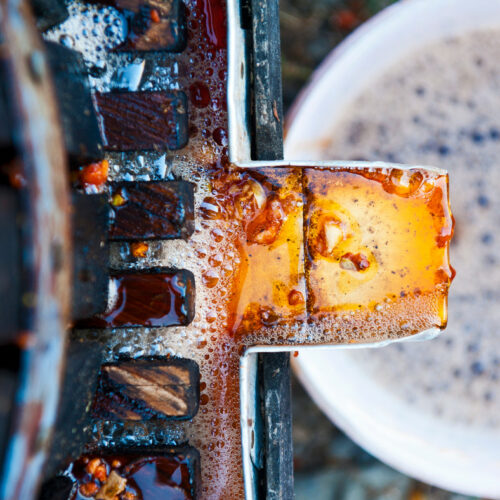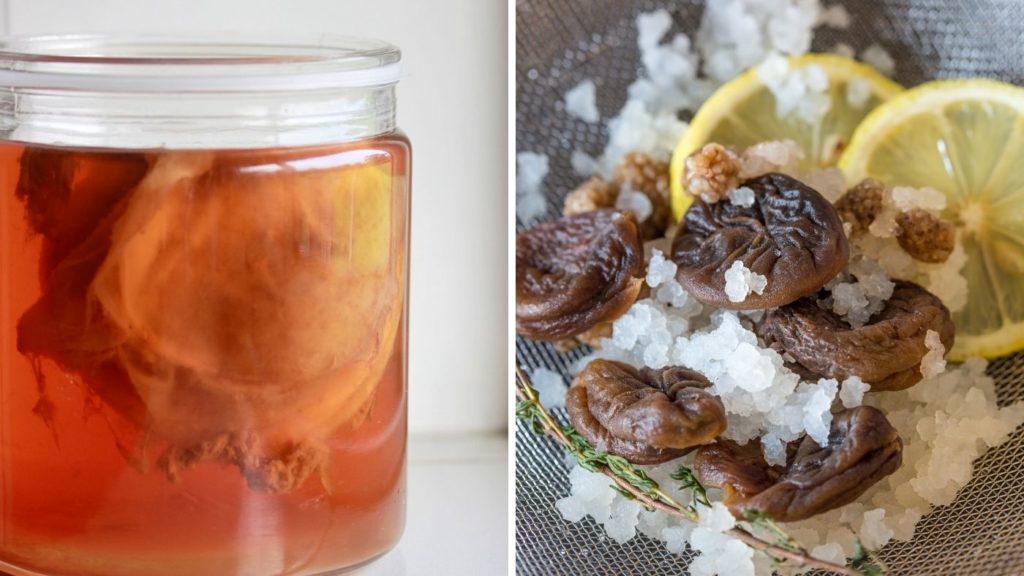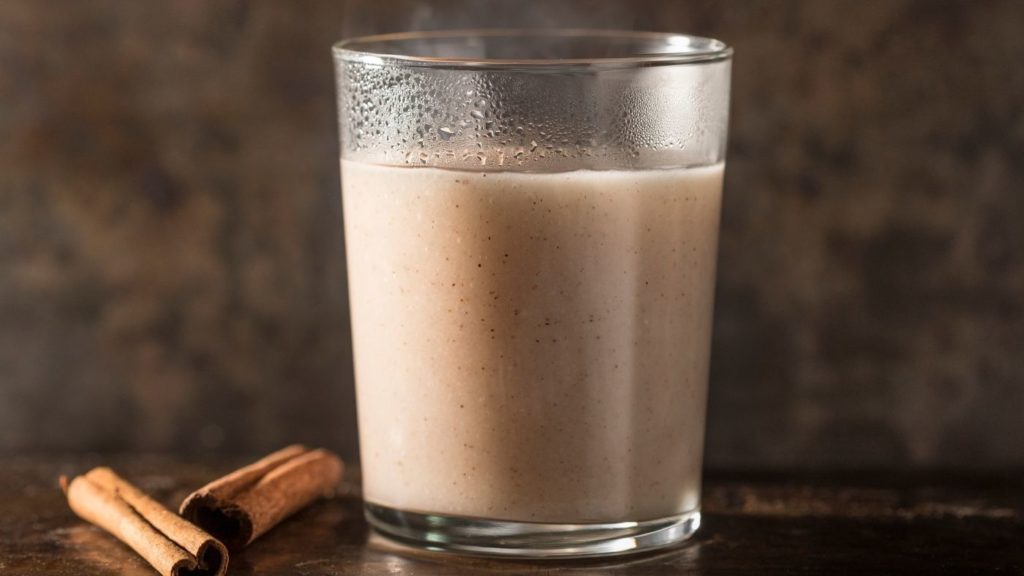Delicious homemade cider vinegar, packed with benefits and probiotics, is within your reach. And the icing on the cake? It’s one of the easiest vinegars to make at home!
You only need three ingredients to make homemade hard apple cider vinegar: apple juice, yeast, and a mother of vinegar. Making your own vinegar is easy and tasty!
Dive into this article and learn how to transform ordinary apple juice or cider into extraordinary vinegar.
Go straight to the section that interests you:
- Ingredients for making homemade apple cider vinegar
- Apple cider vinegar recipe
- Frequently asked questions
How Do I Make Homemade Apple Cider Vinegar?
This apple cider vinegar recipe starts with apple juice. You can also use apple peels and cores.
There are two steps to making apple cider vinegar:
- The apple juice is transformed into cider (alcoholic fermentation).
- The cider is transformed into vinegar (acetic acid fermentation).
These are two successive fermentations, requiring different microorganisms. Alcoholic fermentation must be complete before acetic acid fermentation can begin. You’ll see, it’s easier than it sounds!
If you already have organic cider (preferably homemade), then you’re already one step ahead!
Turning Apple Juice Into Cider
Alcoholic fermentation is the first essential step. Yeast transforms the sugar in the apple juice into alcohol. The apple juice is placed in an oxygen-free environment and yeast is added.
To find out more about how to make cider, see our guide to Making Hard Apple Cider.
Turning Cider Into Vinegar
During the second step (acetic acid fermentation), acetic acid bacteria settle in the cider to transform the alcohol into vinegar. During this step, the bacteria need oxygen to do their work.
Want to find out more about this step? Check out our complete guide on How to Make Vinegar.
Ingredients for Making Homemade Cider Vinegar
Apple Juice
Apple juice should contain no additives such as potassium sorbate or sodium benzoate. Ideally, use organic apple juice.
Yeast
Unpasteurized apple juice naturally contains wild yeast. These may well be suitable, but given their wild nature, they can produce unexpected results.
For greater predictability, we prefer to use a pinch of champagne yeast. This yeast is very effective and gives reliable, consistent results.
Bread yeast can also be used, but it may affect the taste.
Mother of Vinegar
A mother of vinegar contains the acetic acid bacteria essential for making vinegar.
If you don’t have any from a previous vinegar recipe, use raw, unpasteurized commercial vinegar.
To find out more, see What Is a Mother of Vinegar?

Homemade Apple Cider Vinegar Recipe
Equipment
- 1 pierced lid with airlock
- 1 long spoon, for mixing
Ingredients
- 3 L apple juice without additives
- 1 pinch Champagne yeast
- 625 ml mother of vinegar (unpasteurized vinegar)
Steps
Turning the juice into cider
- Wash all equipment thoroughly.
- Pour the apple juice into the fermentation jar. Stir well to aerate the juice.
- Fill a small bowl with warm water. Add the yeast and allow to stand for 10 minutes at room temperature.
- Pour the yeast into the apple juice. Mix well.
- Close the lid and install the airlock. Fill the airlock with water up to the line.
- Sanitize the bottles, then carefully pour in the cider, taking care not to disturb the yeast deposit. Discard the solid residue.
- Leave to ferment at room temperature for at least two weeks, or until there are no more bubbles in the airlock.
Turning cider into vinegar
- Remove the lid and pour the mother of vinegar and its liquid into the cider.
- Cover with a breathable cloth and secure with a rubber band.
- Leave to ferment at room temperature for at least three months.
- Taste. If you like the acidity, go on to the next step. If not, leave to ferment for a few more weeks.
- Bottle in airtight bottles. If desired, save about 625 ml of vinegar for your next recipe.
Notes
Frequently Asked Questions
Where Can I Find a Mother of Vinegar?
The mother of vinegar is a gelatinous film containing acetic acid bacteria that transform alcohol into acetic acid (vinegar). This film is immersed in liquid rich in acetic acid bacteria, which is used to start the fermentation process.
If you’ve already made vinegar, you can use some of it as your mother.
Otherwise, buy unpasteurized (raw) vinegar. Some vinegars say “with mother” on the packaging.
To find out more, see What Is a Mother of Vinegar?
How Do You Speed Up Acetic Acid Fermentation?
The transformation of cider into acetic acid vinegar generally takes a minimum of three months to obtain the desired level of acidity. However, it is possible to shorten this time to just a few weeks by improving the oxygenation of the liquid. One effective method is to use an aquarium aerator in your jar.
How Do I Know If My Vinegar Has the Right PH Level?
Taste can be a good indicator of pH. A more acidic vinegar will have a stronger, pungent taste. The ideal pH level will also depend on the intended use. For example, vinegar used for canning will need a lower (more acidic) pH than one used for salad dressing.
If you’re looking for a measurement, then pH paper strips or a pH meter will be necessary. Commercially available vinegar generally has a pH of between 2 and 3.5.
What Are Common Mistakes to Avoid?
Common mistakes to avoid include:
- Neglecting alcoholic fermentation: The juice must be completely turned into alcohol before acetic acid fermentation can begin.
- Using poor quality ingredients: If you press your own apples, choose fresh, clean apples.
- Insufficient aeration: Vinegar needs oxygen to ferment properly.
- Use of metal containers: use acid-resistant glass or plastic to avoid acid reactions.
Avoiding these mistakes will help you create quality apple cider vinegar at home.
Can Apple Cider Vinegar Be Made from Commercial Cider?
Yes, you can make apple cider vinegar with commercially available cider.
Can I Use a Juice Other than Apple Juice?
Of course, you can! However, it must contain a good amount of sugar to allow the yeast to create enough alcohol. To find out more, see our complete guide on How to Make Vinegar.
Use organic juice with no additives.
Why Is My Vinegar Slow to Ferment?
Vinegar likes to ferment at temperatures between 25 and 30°C (77 and 86°F). If the temperature is lower, fermentation will be slower.
Food additives can also slow down or even prevent fermentation.
What Is Forming on the Surface of My Vinegar?
Vinegar bacteria form a film of cellulose on the surface of the vinegar: a mother of vinegar. Leave it there.
If it’s powdery or looks like mould found on food, unfortunately, you must throw it out.
Why Does My Vinegar Smell Like Nail Varnish?
This is normal, and even a good sign! It indicates that fermentation is underway, but not yet complete. Let it ferment for a few more weeks.
Why Does My Vinegar Taste Like Water?
When vinegar is left to ferment too long, the bacteria no longer have any alcohol to consume. So, they turn to the acids they have just created.
Vinegar left too long in contact with oxygen will oxidize excessively and lose its acidity.
To prevent this from happening, transfer the vinegar into airtight bottles to avoid contact with oxygen.
Can I Use My Homemade Cider Vinegar in Canned Food?
We do not recommend using homemade apple cider vinegar for canning. Canning requires a high percentage of acid.
Homemade cider vinegar can vary greatly in acidity from one recipe to another.

